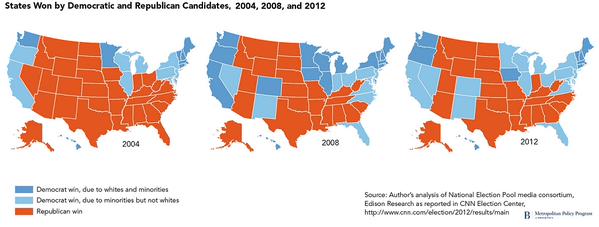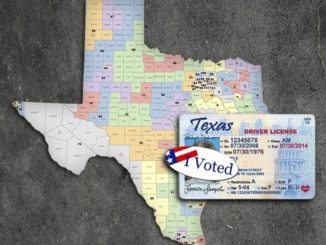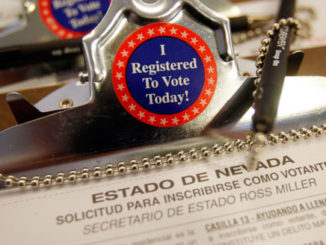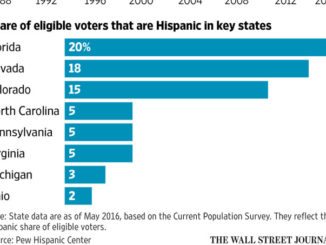
by William H. Frey
The anti-immigrant messages touted by Donald Trump, and now several other Republican primary candidates (envious of Trump’s poll numbers), seem oblivious to the growth of America’s Latino and other minority voting populations and the inherent electoral implications.
Granted, Republican primary voters are whiter, older, and more conservative than the more diverse general election turnout, which of course holds the key to the presidency.
Yet, will focusing on the older white vote, whether by Trump or one of his emulators, guarantee a general election loss due to increasing minority clout? The answer is not as simple as it may seem.
The core positions of Trump’s “Make America Great Again” agenda hold appeal to those who yearn for a whiter, more insular America of yore. As I argue in my book “Diversity Explosion,” it was more youthful racial minorities—the implicit targets of anti-immigrant ire—who were responsible for both of Barack Obama’s presidential wins.
A key to Obama’s wins in 2008 and 2012 was his ability to take several Southern and Western states previously dependably Republican. Changes in the racial demography of these states—the dispersion of Hispanics across the Sun Belt and the ongoing return of blacks to the South—had much to do with this. The three maps displayed below depicting state outcomes in the last three presidential elections make this plain.
George W. Bush’s 2004 election followed a pattern observed in several earlier GOP presidential victories: Republican wins in fast growing states in the South and Mountain West, as well as the Great Plains which bested Democratic wins on the slower growing urbanized coasts and industrial Northeast and Midwest (Ohio excepted). The Republican dominance of the South was fairly consistent (with the exceptions of the elections of Democratic Southerners Jimmy Carter and Bill Clinton) since the passage of the civil rights legislation in the 1960s, largely due to the heavy support of white Southerners. Republican wins among the largely white Mountain West states were also fairly common from 1968 through 2004.
This changed in 2008 and 2012 in no small part due to the demographic rise of minorities in the Sun Belt voting Democratic. (In Nevada, for example, the minority share of voters rose from 20 percent in 2004 to 33 percent in 2012). Obama won the new Southern and Western battleground states of Nevada, New Mexico, Colorado, Virginia, North Carolina, and Florida in 2008 and all of these but North Carolina again in 2012.
Perhaps even more important is the fact that minorities and not whites were responsible for all of those wins except for Colorado in 2008 (where both minorities and whites voted Democratic). In other words, these wins showed that traditionally strong white Republican support in Southern and Western states can be overcome by a growing and enthusiastically Democratic minority electorate as the demography of the Sun Belt changes.
But what about previously Democratic strongholds in Northern states? Here Obama was successful, including capturing Ohio. But it was also the case that in 2012, more so than in 2008, his victories in many of them depended solely on the minority vote. In a broad swath of mostly white states from Minnesota to Pennsylvania, Obama’s enthusiastic support from a relatively small minority population was able to tip the balance against majority white support for Republican Mitt Romney.
This suggests that these non-Sun Belt states may be vulnerable for Democrats if the Republican candidate can capture a greater number of older whites—a growing share of voters in most of these aging states. In fact Ohio and Pennsylvania, representing 38 Electoral College votes, were among the closest of Obama’s wins in 2012. When adding Michigan, Minnesota, and Wisconsin, this five state group constitutes 74 Electoral College votes—a substantial potential haul for Republicans in 2016; and one on par with the 77 Electoral College votes of the combined recent Democratic Sun Belt conquests: Colorado, Florida, Nevada, New Mexico, North Carolina, and Virginia
Of course, the long term demographic trends of the country will bring a rise in the minority population (and voters) everywhere. Candidates or parties that focus only on whites or older whites are doomed to eventual political extinction. But in the short run, political geography suggests that Republican, and Democratic, presidential candidates will need to find ways to appeal to older white voters without alienating minority voters. The problem with a Trump-like message is that it may accomplish the former but certainly not the latter. The backlash that message will generate among minorities and younger voters makes it a risky political strategy for Republicans in 2016—and potentially divisive for the nation in the future.
William H. Frey is Senior Fellow, Metropolitan Policy Program at Brooking Institute



